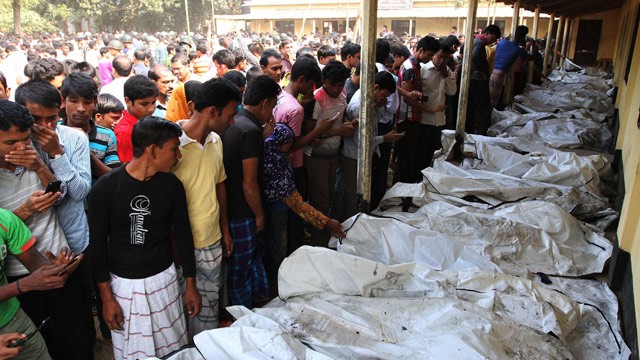 |
| source ABC News |
Many of you probably have seen a tidbit of news about the Bangladesh Garment Factory fire that happened the Saturday after Thanksgiving (USA). And if you are a long time sewing blog reader you've probably heard of the Triangle Shirt-Waist Factory Fire that sparked (pardon the pun) a labor rights movement in the early 20th century United States. Both of these tragedies share a common story of lack of safety standards for the facility, along with grueling working conditions of those employed there. With workers being locked in the building for 10-12 hours a day and told they should be happy just to have a job. This is even the PR schtick you hear from companies that use these factories. "We're bringing jobs to poor countries, we're doing a good deed!" Sorry, I'm not drinking your kook-aid anymore.
I think, in this modern world where its just so easy to go to the store and buy a new shirt because the button popped off the old one, we forgot that actual hands sewed those garments together. There is a human cost in every item of clothing you own, not to mention material and environmental. Sewing is one of the most common professions in the world (Overdressed pg. 659 kindle version) because of its very labor intense nature. For a majority of Western society we have become disconnected with what this means and have failed to recognize the value clothing really should have. Here was a statistic, also taken from Overdressed, that had me reeling in shock:
"Every year, Americans throw away 12.7 million tons, or 68 pounds of textile per person, according to the Environmental Protection Agency, which also estimates that 1.6 million tons of this waste could be recycled or reused."Every bit of that clothing was made by people, most likely in a developing nation in conditions similar to the two factories mentioned above. And from this statement I have several points that I could make but they are all things that deserve their own blog post(so... brace yourself). And according to ABC, this brings the number of deaths due to garment factory fires over 600 in the past five years in Bangladesh alone. Unsurprisingly, we're starting to see workers band together and protest for better working conditions. Chinese workers have been doing this too, and not just for the garment industry, for several years now which is why production has started moving to even poorer countries.
So, what should I say in conclusion? I say question the label and the price tag. I say educate yourself on what it is that you are buying and why. Just like healthy food its possible to do the right thing on a budget, it just takes more effort on your part. Learning to sew a button back on that shirt can't be so bad if it saves a life in another country, right?
Now excuse me while I take my soapbox back to the kitchen. I gotta reach something on the top shelf.

I have to agree with your assessment and your anger. It warrants a bah, humbug...
ReplyDeleteUnionize!! Yes, absolutely, we need to realize that our RTW shirt costs 15 bucks because (in part) the workers are being exploited - even up to the point that it costs lives. And I totally agree that instead of simply feeling guilty and feeling like there is no alternative, that we can take action by repairing our clothes and even making some of them our own. Not everyone wants to sew their own garments and I respect that, but definitely anyone can do the minimal maintenance and repairs to keep a shirt 5 years instead of 5 months.
ReplyDeleteWell said!
ReplyDeleteWell said.
ReplyDelete